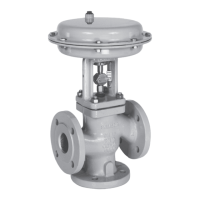EB 8026 EN 4-3
Shipment and on-site transport
− Protect the piping and any mounted
valve accessories against damage.
− Protect the control valve against moisture
and dirt.
− The permissible transportation tempera-
ture of standard control valves is –20 to
+65°C (–4 to +149°F).
Contact our after-sales service for the trans-
portation temperatures of other valve ver-
sions.
Fig.4-1: Lifting points on the control valve
4.3.2 Lifting the valve
To install a large valve into the pipeline, use
lifting equipment (e.g. crane or forklift) to lift
it.
Note
Lifting instructions
− Use a hook with safety latch (see
Fig.4-1) to secure the slings from slip-
ping off the hook during lifting and
transporting.
− Secure slings against slipping.
− Make sure the slings can be removed
from the valve once it has been installed
into the pipeline.
− Prevent the control valve from tilting or
tipping over.
− Do not leave loads suspended when in-
terrupting work for longer periods of
time.
− Make sure that the axis of the pipeline is
always horizontal during lifting and the
axis of the plug stem is always vertical.
− Make sure that the additional sling be-
tween the lashing point on the actuator
and rigging equipment (hook, shackle
etc.) does not bear any load when lifting
valves larger than NPS6. The sling only
protects the control valve from tilting
while being lifted. Before lifting the con-
trol valve, tighten the sling.
Lifting the control valve
1. Attach one sling to each ange of the
body and to the rigging equipment (e.g.
hook) of the crane or forklift (see
Fig.4-1).
2. If necessary, attach others sling to the
lashing point on the actuator and to the
rigging equipment.

